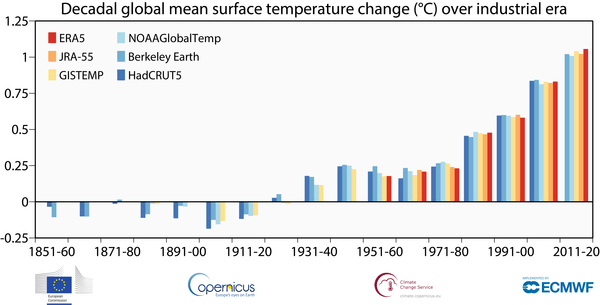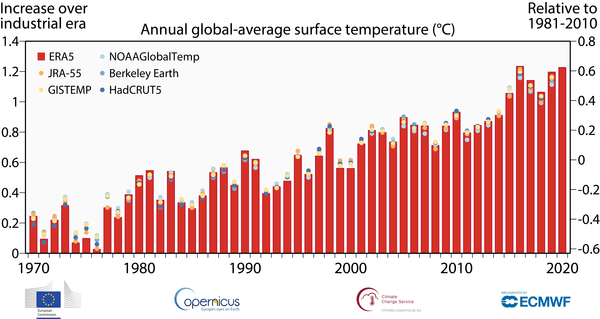Copernicus: 2020 warmest year on record for Europe; globally, 2020 ties with 2016 for warmest year recorded
The Copernicus Climate Change Service (C3S) today reveals that globally 2020 was tied with the previous warmest year 2016, making it the sixth in a series of exceptionally warm years starting in 2015, and 2011-2020 the warmest decade recorded. Meanwhile, Europe saw its warmest year on record, 0.4°C warmer than 2019 which was previously the warmest year. Together with the Copernicus Atmosphere Monitoring Service (CAMS), C3S also reports that CO2 concentrations in the atmosphere have continued to rise at a rate of approximately 2.3 ppm/year in 2020 reaching a maximum of 413 ppm during May 2020. Both C3S and CAMS are implemented by the European Centre for Medium-Range Weather Forecasts on behalf of the European Commission with funding by the European Union.

Decadal averages of global air temperature at a height of two metres estimated change since the pre-industrial period according to different datasets: ERA5 (ECMWF Copernicus Climate Change Service, C3S); GISTEMPv4 (NASA); HadCRUT5 (Met Office Hadley Centre); NOAAGlobalTempv5 (NOAA), JRA-55 (JMA); and Berkeley Earth. (Credit: Copernicus Climate Change Service/ECMWF)
C3S’s dataset for surface air temperatures shows that:
- Globally, 2020 was on a par with the 2016 record
- 2020 was 0.6°C warmer than the standard 1981-2010 reference period and around 1.25°C above the 1850-1900 pre-industrial period
- This makes the last six years the warmest six on record
- Europe saw its warmest year on record at 1.6°C above the 1981-2010 reference period, and 0.4°C above 2019, the previous warmest year
- The largest annual temperature deviation from the 1981-2010 average was concentrated over the Arctic and northern Siberia, reaching to over 6°C above average
Furthermore, satellite measurements of global atmospheric CO2 concentrations show that:
- CO2 global column-averaged maximum reached 413 ppm
- CO2 continued to rise in 2020, increasing by 2.3 ± 0.4 ppm, slightly less than the growth rate of the previous year
Parts of the Arctic and northern Siberia saw some of the largest annual temperature deviations from average in 2020, with a large region seeing deviations of as much as 3°C and in some locations even over 6°C for the year as a whole. On a monthly basis, the largest positive temperature anomalies for the region repeatedly reached more than 8°C. Western Siberia experienced an exceptionally warm winter and spring, a pattern also seen over summer and autumn in the Siberian Arctic and over much of the Arctic Ocean.
Furthermore, the wildfire season was unusually active in this region, with fires first detected in May, continuing throughout summer and well into autumn. As a result, poleward of the Arctic Circle, fires released a record amount of 244 megatonnes of carbon dioxide in 2020, over a third more than the 2019 record. During the second half of the year, Arctic sea ice was significantly lower than average for the time of the year with July and October seeing the lowest sea ice extent on record for the respective month.
In general, the Northern Hemisphere experienced above average temperatures for the year, apart from a region over the central North Atlantic. In contrast, parts of the Southern Hemisphere saw below average temperatures, most notably over the eastern equatorial Pacific, associated with the cooler La Niña conditions developing during the second half of the year. It is notable that 2020 matches the 2016 record despite a cooling La Niña, whereas 2016 was a record year that began with a strong warming El Niño event.

Annual averages of global air temperature at a height of two metres estimated change since the pre-industrial period (left-hand axis) and relative to 1981-2010 (right-hand axis) according to different datasets: Red bars: ERA5 (ECMWF Copernicus Climate Change Service, C3S); Dots: GISTEMPv4 (NASA); HadCRUT5 (Met Office Hadley Centre); NOAAGlobalTempv5 (NOAA), JRA-55 (JMA); and Berkeley Earth. (Credit: Copernicus Climate Change Service/ECMWF)
Europe 2020: warmest year on record
2020 was Europe’s warmest year recorded, and seasonally winter 2019/20 and autumn 2020 were also the warmest recorded. Winter 2020, meaning December 2019 to February 2020, exceeded the previous warmest of 2016 by almost 1.4°C, while autumn (September to November 2020) passed the old record set in 2006 by 0.4°C. In addition, western Europe experienced a significant heatwave in late July and early August. The next four warmest years for Europe also happened during the last decade.
A full and detailed analysis of Europe’s climate will be released in April when Copernicus presents its annual European State of the Climate 2020.
Carlo Buontempo, Director of the Copernicus Climate Change Service (C3S), comments: "2020 stands out for its exceptional warmth in the Arctic and a record number of tropical storms in the North Atlantic. It is no surprise that the last decade was the warmest on record, and is yet another reminder of the urgency of ambitious emissions reductions to prevent adverse climate impacts in the future."
CO2 concentrations continue to rise in 2020

Monthly global CO2 concentrations from satellites (top panel) and derived annual mean growth rates (bottom panel) for 2003-2020. Top: column-averaged CO2 (XCO2) based on the C3S/Obs4MIPs (v4.2) consolidated (2003-2019) and CAMS preliminary near-real time data (2020) records. The listed numerical values in red indicate annual XCO2 averages. Bottom: Annual mean XCO2 growth rates derived from data shown in the top panel. The listed numerical values correspond to the growth rate in ppm/year including an uncertainty estimate in brackets. (Source: University of Bremen for Copernicus Climate Change Service and Copernicus Atmosphere Monitoring Service/ECMWF)
Analysis of satellite data reveals that carbon dioxide concentrations have continued to rise in 2020 reaching an unprecedented global column-averaged maximum of approximately 413.1 ppm. The estimated annual mean XCO2 growth rate for 2020 was 2.3 ± 0.4 ppm/year. This is less than the growth rate in 2019, which was 2.5 ± 0.2 ppm/year and also less than the 2.9 ppm/year increase in 2015 and 2016. However, 2015 and 2016 experienced a strong El Niño climate event, which resulted in a larger atmospheric growth rate due to a weaker than normal uptake of atmospheric CO2 by land vegetation and large CO2 wildfire emissions, particularly in Indonesia in those years. The wildfires in the Arctic and Australia in 2020, although of unprecedented magnitude in their regions, represent only a small fraction of global fire emissions.
Vincent-Henri Peuch, Director of the Copernicus Atmosphere Monitoring Service (CAMS), comments: “While carbon dioxide concentrations have risen slightly less in 2020 than in 2019, this is no cause for complacency. Until the net global emissions reduce to zero, CO2 will continue to accumulate in the atmosphere and drive further climate change.”
In the context of the COVID-19 pandemic, it has been estimated by the Global Carbon Project that there was a reduction of around 7% of fossil CO2 emissions.
“To what extent this was a factor in the lower total increase is debatable though, as the variations in global growth rate are dominated by natural processes. We must continue efforts to decrease CO2 net emissions to reduce the risk of climate-related change”, Vincent-Henri Peuch adds.
“The extraordinary climate events of 2020 and the data from the Copernicus Climate Change Service show us that we have no time to lose. We must come together as a global community, to ensure a just transition to a net zero future. It will be difficult, but the cost of inaction is too great, which is why the commitments made under our European Green Deal are so very necessary”, highlights Matthias Petschke, Director for Space, European Commission’s Directorate-General for Defence industry and Space.
More information on how the data was compiled: https://climate.copernicus.eu/sites/default/files/2021-01/C3S-Annual-end-of-year-2020_notes-to-editors.pdf
- Source:
- Copernicus
- Author:
- Press Office
- Link:
- climate.copernicus.eu/...
- Keywords:
- Copernicus, climate change, 2020, global, Europe, warm, temperature, CO2, atmosphere, EU, forecast
























